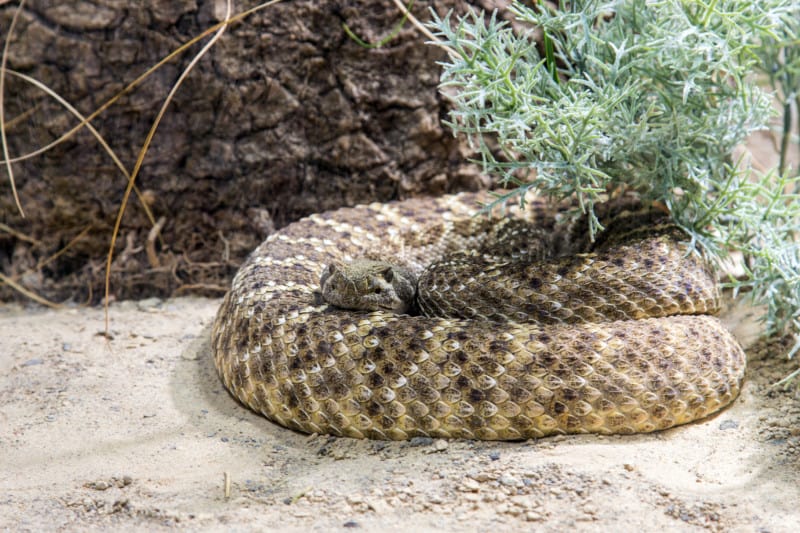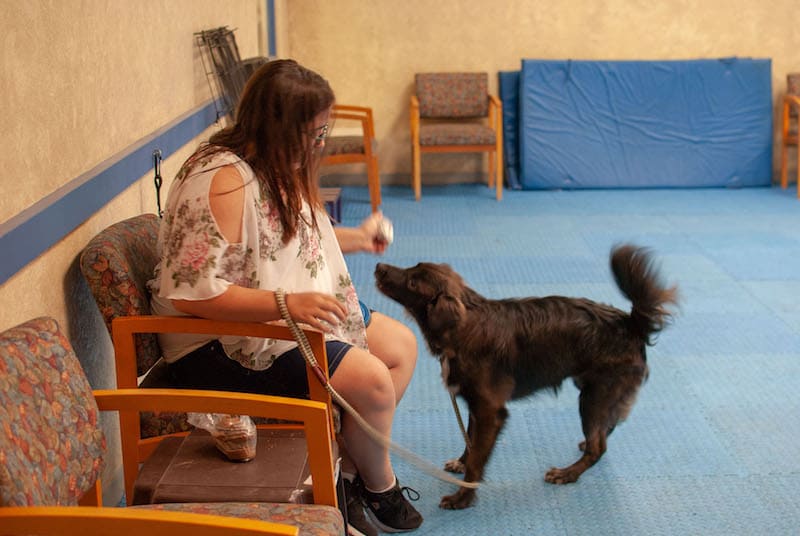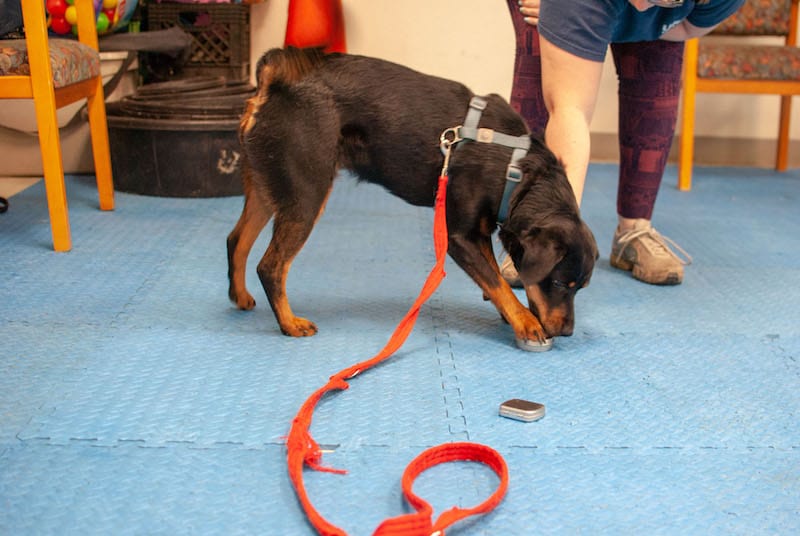From hiking trails to your own back yard, rattlesnakes can pose a real danger to our pets. Most rattlesnake avoidance classes use aversive pain-based methods, but there are alternatives!
Moving to the desert opened my eyes to all kinds of new dangers as a dog owner. In addition to needing essential gear for dog friendly desert hiking in our backpacks, I also learned about rattlesnake avoidance training. Many of my hiking friends have gone through this training with their dogs, and I’ve heard stories of their dogs successfully avoiding snakes on the trail.
But here’s the thing about rattlesnake avoidance training: 99% of the classes out there use e-collars, or electric shock collars. While most of the people I spoke with felt this was better than a rattlesnake bite, I knew there had to be another option.
Who Needs Rattlesnake Training For Dogs?
Overall, less than 1% of dogs and cats in the U.S. are bit by snakes. However, if you live in an area prone to rattlesnakes, your odds are obviously higher. About 85% of rattlesnake bites to dogs occur in the dog’s in the backyard, so if you have a backyard where your pets roam freely, or if you hike with your dog (especially off-leash) in a place where rattlesnakes are common, avoidance training is a good investment to keep your pet safe.
Sidney Hardie, of Southwest Airedale Terrier Rescue, unfortunately learned this lesson the hard way. She’s raised many Airedales on her Tucson acreage without issue. But a few year ago two of her dogs confronted a rattlesnake in the yard.
The vet bill for the dog that took the brunt of the attack? $2,234, plus untold heartache wondering if the dog would pull through after a night in the doggy E.R. (Happily, both dogs are okay!)
READ MORE ⇒ What You Should Know About Emergency Vets (Before You Need One)

Why Not Shock?
For my dog, Bailey, and me, training has always been fun. So, learning that most snake avoidance classes rely on painful shock collars, I faced a dilemma. Of course, I don’t want Bailey to be bitten by a rattlesnake. But I also don’t want her to suffer during the training process. What makes it worse is that there’s evidence this type of training doesn’t work for all dogs!
Generally in these classes, the dog encounters a live rattlesnake that’s been muzzled, had its fangs removed, or been milked of its venom. Then, while the dog is near the snake, a painful shock is delivered via the e-collar.

The idea is to teach the dog that snakes equal pain and should be avoided. In theory, this can be an effective strategy. However for some dogs, this type of training can result in unwanted side effects and might even produce the opposite behavior of what’s intended.
Because the trainer cannot control what connections the dog is making, this type of training can be unpredictable. Some dog might develop a fear of oscillating sprinklers, which can sound like a rattlesnake. Other dogs, rather than learning to avoid the snake, could choose to attack instead!
Snake Avoidance Training Without Shock
Given my reservations, I began looking for a different type of rattlesnake training for dogs. I called dozens of Arizona dog trainers. Most of them said that shock collar training was the only option. Fortunately, I kept digging and found Jamie Robinson, a dog and cat trainer in Tucson.
Jamie Robinson, of Brains Bones & Behavior, specializes in many areas of dog training, including medical alert service dog training and canine & feline cancer detection. She uses the same basis of techniques for all of her training — introducing sight, smell, and sound an then teaching the expected behavioral response. In the case of rattlesnake training, the rewarded response is to run away when the dog becomes aware of a snake.
You can take the positive reinforcement snake avoidance course in person in Tucson, Arizona. Options include six weekly classes (with homework!) or attending the course over a weekend. The cost is $125. Or you can order the class online for $65 and progress at your own pace.

How Does Positive Rattlesnake Avoidance Training For Dogs Work?
With an e-collar, a snake aversion training class might only last one hour. The positive reinforcement method takes longer, but spreading the course over six weeks allows the dogs time to learn without pain. These are the steps:
Step 1: Using real rattlesnake scent, dogs learn to identify the scent of a rattlesnake through positive reinforcement.

Step 2: Go away! Trains dogs to run away on command.
Step 3: Combining Steps 1 and 2. Dog learn to run away upon smelling the snake.
Step 4: Using toy snakes, often combined with the scent, dogs learn to recognize snakes by sight.

Step 5: Finally, the sound is added. Using maracas or phone apps to mimic the sound, dog learn to avoid use their hearing to avoid rattlesnakes.

For the remaining steps, and the final two weeks of class, a live rattlesnake is introduced to ensure the training has worked. Through repetitive positive reinforcement, dogs learn to run away as soon as they smell, see, or hear a rattlesnake.
Where To Find Positive Rattlesnake Avoidance Training
Positive reinforcement rattlesnake avoidance training is becoming more popular. In addition to Jamie’s course in Tucson, you can now find classes in Colorado, Las Vegas, Nevada, and Escondido, California.
If you don’t live close to one of these trainers, but have rattlesnakes in your area, look for a local positive-reinforcement trainer and ask if you can arrange private training that is appropriate for your dog.
For those confident in their training skills, you can also try an online course or start with Jaime’s booklet and flashcards on snake avoidance without shock.
Have you trained your dog to avoid rattlesnakes? How was your experience?
The post Rattlesnake Training for Dogs: Teaching Snake Avoidance appeared first on GoPetFriendly.com.
-----------------------------------------------------------------------------------------------------------------
By: Leigh Wilson
Title: Rattlesnake Training for Dogs: Teaching Snake Avoidance
Sourced From: www.gopetfriendly.com/blog/rattlesnake-training-for-dogs-the-411-on-snake-avoidance/
Published Date: Thu, 15 Apr 2021 09:30:00 +0000






